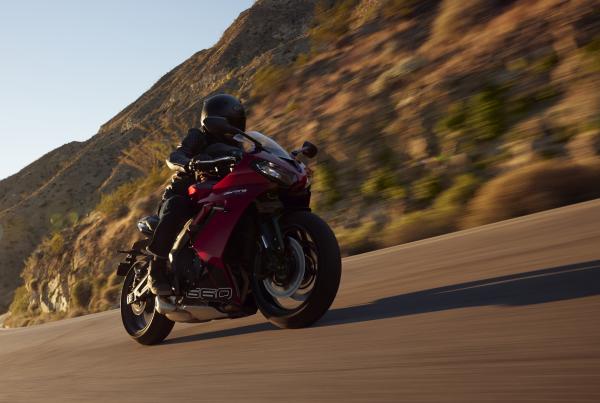
There’s nothing like the revival of an iconic sports bike name for inflaming opinions – Yamaha’s R7 isn’t a patch on the 1999 OW-02 original, for instance, or Honda’s revived CBR600RR hasn’t the power of the old. So, when Triumph revived its historic Daytona moniker with this week’s new, Trident-based Daytona 660 some kind of outrage was inevitable.
Or was it?
“Should have done a new Daytona 765 based on the Street Triple,” say some. “Not a true Daytona,” typed other keyboard warriors…
For my money, however (it’s priced well, too), albeit without admittedly having the benefit of riding it yet, it IS. In fact, I’d go so far as saying it’s not only a true Daytona, it might be the best and likely most popular one yet and also looks set to be the leading example in what’s quickly becoming one of the most popular categories of all – affordable, middleweight, road-orientated sports bikes.
Image via Wikimedia
To quote Lloyd Grossman from the early 1990s TV show ‘Through the Keyhole’ (we’re being retrospective, here, it’s appropriate), ‘let’s look at the evidence’:
First, forget the recent 675/765 for a moment (we’ll get back to it), Daytonas have rarely been pure, purpose-built sports bikes, anyway. Triumph’s first, in 1967, was a tuned version of the then Tiger 100 500cc twin built and named to commemorate Buddy Elmore’s win at the 1966 Daytona 200.
Its Hinckley revival in the early ‘90s was no more than a sports-faired version of its modular Tridents and Trophy models, while even the most pure-bred, big-bore example of them all, the 1997 T595, which evolved into the 955, was always a road rather than track machine and one developed in parallel with a naked roadster, the T509 Speed Triple, which outlived it.
So to think of the Daytona as something that's always been a purebred track bike isn't quite right. The 2002 Daytona 600 was an updated, renamed version of the TT600 (early versions of which which had a reputation for poor fuelling) had been targeted at Honda’s CBR600F and whose only race success came at the 2003 TT with the significant help of Bruce Anstey and tuner Jack Valentine.
That bike was superceded by 2005’s Daytona 650 which grew to 646cc so ruling it out of any supersport race eligibility. And even 2006’s all-new Daytona 675 triple, while admittedly a diamond and a great track bike, was a little less focused rivals such as Honda’s CBR600RR and Suzuki’s GSX-R. That helped it out-live both of its key rivals, but it was still ultimately usurped by its more popular roadster brother, the Street Triple.
Second, the new 660 is much more than ‘just’ a faired Trident. Like the 1967 original, its engine has been significantly reworked to increase performance. In Trident form, the 660cc triple put out an already respectable, competitive 80bhp. In Daytona trim, with a new head, cams, crank, exhaust and throttle bodies, that’s not only boosted by a healthy 17 per cent but there’s more torque and it revs higher, too.
The resulting peak power – 94bhp – should not only blow away the 67bhp of Kawasaki’s Ninja 650, the 72bhp of Yamaha’s R7 and the 82bhp of Suzuki’s imminent GSX-8R, it’s also on par with Honda’s four-cylinder CBR650R and just 6bhp behind Aprilia’s far more expensive RS660. The chassis is uprated as well, with sharper steering geometry than the Trident and has a longer wheelbase, too.
The 660’s also more sophisticated and better equipped than both the its rivals and the Trident. Triumph itself claims the new Daytona has ‘the highest quality, capability and specification in its class’, and they’ve got a point. Along with three riding modes, switchable traction and uprated dash from the Street Triple it also has improved four-piston radial brakes, none of which can be matched by those Japanese rivals.
Third and finally, as alluded to earlier (and best of all) is the new Daytona’s 660’s price. At £8595, Triumph’s newcomer not only undercuts Suzuki’s less powerful, twin-cylinder £8899 GSX-8R (above), it’s also less than the more basic Honda CBR, significantly cheaper than the Aprilia and only £405 more than Yamaha’s 72bhp R7 twin.
So, is the new Daytona 660 a genuine ‘supersports’? Maybe not, if your benchmarks are the CBR600RR and ZX-6R, but few are currently buying them anyway. Triumph said at a preview event it thinks the part of the market a more focused 765-engined new Daytona might occupy is as good as good. Instead, with 94bhp, a characterful triple, £8,595 tag, plenty of classy touches and a real-world ‘road’ attitude, it has an irresistible appeal all its own.
And is it a genuine ‘Daytona’? Yes, very much so, and quite possibly the one many of us will want most. Don’t forget: Triumph’s last Daytona was the limited edition Daytona 765 Moto2 edition in 2020 which cost nearly £16,000.
This one also promises plenty of class-leading fun – but at nearly half the price.

